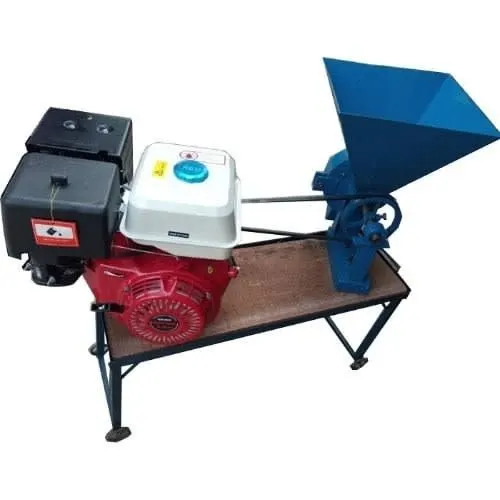A grind mill with a petrol engine is a mechanical device used to grind various materials such as grains, nuts, seeds, and spices into finer particles or powder. It is commonly used in agricultural, industrial, and domestic applications, especially in areas with limited access to electricity.
1. Components of a Grind Mill with Petrol Engine
A. Grinding Mechanism
The grinding mechanism consists of different parts that work together to break down materials into smaller particles.
- Grinding Chamber: This is the main compartment where grinding occurs.
- Grinding Discs (Burrs) or Blades: These can be either stone, metal, or steel discs that crush and grind the materials.
- Hopper: A funnel-like opening where materials are fed into the grinding chamber.
- Output Chute: The section from which the ground material exits after processing.
B. Petrol Engine
The petrol engine is the power source that drives the grinding mechanism. It consists of:
- Engine Block: The core of the engine housing the cylinders.
- Carburetor: Mixes air and fuel to provide combustion.
- Fuel Tank: Stores petrol to power the engine.
- Spark Plug: Ignites the fuel-air mixture for combustion.
- Cooling System: Usually air-cooled to prevent overheating.
- Exhaust System: Expels gases produced from combustion.
- Pull Start or Key Start Mechanism: Used to start the engine.
C. Transmission System
- Belt and Pulley System: Transfers power from the engine to the grinding mechanism.
- Gearbox (if available): Adjusts speed and torque for efficient grinding.
D. Frame and Stand
- A metal frame supports the entire system.
- It may have wheels for easy mobility.
2. Working Principle of a Grind Mill with Petrol Engine
- Starting the Engine: The operator fills the fuel tank, checks the oil, and starts the engine using a pull cord or key ignition.
- Power Transmission: The rotating motion from the petrol engine is transmitted via a belt to the grinding mechanism.
- Grinding Process:
- Raw materials are fed through the hopper into the grinding chamber.
- The rotating burrs or blades crush the materials into finer particles.
- The processed material exits through the outlet.
- Adjustments: Some mills have an adjustable setting to control the fineness of the output.
- Shutdown: The engine is switched off after grinding, and the system is cleaned for future use.
3. Features and Specifications
- Power Output: Typically ranges from 5 HP to 15 HP.
- Grinding Capacity: Varies from 50 kg/hour to 500 kg/hour, depending on the model.
- Fuel Consumption: Generally 0.5 to 1.5 liters per hour.
- Material: The grinding mechanism is often made of hardened steel or cast iron.
- Portability: Many models come with wheels for easy transportation.
- Maintenance: Requires regular oil changes, filter cleaning, and blade sharpening.
4. Advantages of a Petrol Engine Grind Mill
✅ No Electricity Required – Ideal for remote locations.
✅ High Mobility – Can be transported easily.
✅ Powerful Performance – Can grind a variety of materials efficiently.
✅ Durable Construction – Long-lasting metal parts ensure longevity.
✅ Easy to Operate – Simple mechanism with minimal training required.
5. Applications
- Agriculture: Grinding maize, millet, wheat, sorghum, and animal feed.
- Food Processing: Making flour, spice powder, and coffee grinding.
- Industrial Use: Processing materials like limestone, charcoal, or clay.
- Small-Scale Businesses: Used by local millers and entrepreneurs.
6. Maintenance and Safety Tips
- Regularly check the oil and fuel levels.
- Clean the grinding chamber to prevent blockages.
- Sharpen or replace grinding burrs or blades when they wear out.
- Ensure the belt and pulleys are properly aligned.
- Use the machine in a well-ventilated area to avoid carbon monoxide poisoning.
- Always wear protective gear like gloves and goggles while operating.
Conclusion
A grind mill with a petrol engine is a versatile and efficient machine, especially useful in areas with unreliable electricity. It is widely used for agricultural and small-scale industrial applications due to its portability, durability, and high grinding efficiency. Regular maintenance ensures its longevity and consistent performance.


![Sumec Firman3.0kva KEY START Generator [4500 D]](https://perkgloballinkslimited.com/wp-content/uploads/2025/01/gennne-300x300.webp)

![Sumec Firman Generator SPG2200 1.5kva [3000D]](https://perkgloballinkslimited.com/wp-content/uploads/2025/01/Screenshot-2025-01-04-at-4.14.03 PM-300x300.png)
Reviews
There are no reviews yet.